|
|
| |
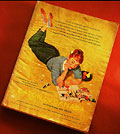 |
|
| |
 "Will
I be pretty, Will I be rich?" she hums to herself. Eaton's (Montreal)
Spring/Summer Catalogue, 1959, cover. "Will
I be pretty, Will I be rich?" she hums to herself. Eaton's (Montreal)
Spring/Summer Catalogue, 1959, cover.
|
|
| |
|
|
|
Fe-mail: Women in Eaton's Toronto Mail-order
Catalogues
by Lorraine
O'Donnell
Women were the primary targets of Eaton's
(Toronto)
mail-order catalogues, because they were usually the ones who purchased
their
own and their families' personal items. The catalogues appealed to
them
in their roles as housewife and mother, glamorous career woman, and model
citizen.
Girls were encouraged through the catalogues to emulate their
mothers'
shopping habits.
Introduction to a Love Story
| Little Women, Girlish Fun | Calling All Teenagers
| Adult "Women of Canada" |
Career Women
| Housewives | Pleasure Seekers
|
Conclusion
|
| |
Introduction to a Love Story
An Eaton's wag once told his customers that "instead of mail it
should
be called 'fe-mail,' since women do most of the buying." That
was
in 1924, and by then it was no secret: The Eaton's Toronto catalogue
and
its women readers were in a relationship that went beyond just
business.
| |
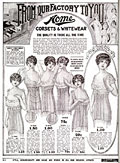 |
|
| |
 Pretty
females and productive factories: the Eaton company's idea of a perfect
match. Eaton's (Toronto) Spring/Summer Catalogue, 1915, p. 110. Pretty
females and productive factories: the Eaton company's idea of a perfect
match. Eaton's (Toronto) Spring/Summer Catalogue, 1915, p. 110.
|
|
| |
|
|
|
Since the founding of the catalogue in 1884, millions of Canadian
females
had become devoted to the Eaton's book. Mrs. Lynde, a character in Lucy
Maude
Montgomery's 1917 novel Anne's House of Dreams,
protested
that the catalogues were "the Avonlea girls' Bible now …
They
pore over them on Sundays instead of studying the Holy Scriptures."
Eaton's
certainly returned the sentiment, using the catalogue to woo what it
called its
"lady readers." The catalogue spoke to them directly,
intimately,
as "you." "From Our Factory to You," says the
headline
of an underwear page in the 1915 spring-and-summer book, for example.
Below,
a blurb extolls the quality of Eaton's-made merchandise, amid pictures of
company
knitting mills vigourously puffing smoke … and of pretty women and
girls
wearing nothing but their unmentionables.
It was no accident that the picture made the females look so pretty and
the
factories so productive. After all, Eaton's was trying to charm the ladies
it
addressed (not to mention undressed) and that involved appealing somewhat
to
their vanity. In this same spirit of flattery, the company emphasized the
excellence
of its merchandise, the implication being that women who bought their
goods were
smart shoppers. In so doing, Eaton's managed to make itself look good too.
| |
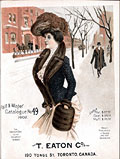 |
|
| |
 A
message to stylish young women: Trust Eaton's. Eaton's (Toronto)
Fall/Winter
Catalogue, 1902, cover. A
message to stylish young women: Trust Eaton's. Eaton's (Toronto)
Fall/Winter
Catalogue, 1902, cover.
|
|
| |
|
|
|
The firm likewise routinely boasted about the mail-order book itself.
Eaton's
called it the "woman's news," and proposed to put in its
pages
much that women would want to know, be it fun, like the latest coat
colours,
or more practical, like testing the garments' wool content. And, the
company
promised to provide women with practically everything they would want to
buy.
Trust us, Eaton's seemed to say, to give you the guidance and the goods,
whether
light-hearted or serious, that you need.
So it was that Eaton's tried to seduce women with the message that it
understood
something slightly paradoxical about them. Yes, we know you are hard
workers
and smart buyers, suggested the catalogue, but we also realize that you
might
want a treat or a compliment now and then. Like a love letter, then, the
catalogue
said as much about the ardent suitor as the object of love.
Let us now leaf through the pages of some of the old Toronto catalogues
to
see how the they portrayed women and in so doing, coaxed them to choose
Eaton's.
|
Little Women, Girlish Fun
| |
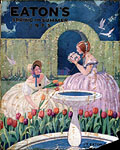 |
|
| |
 Girls
sitting pretty. Eaton's (Toronto) Spring/Summer Catalogue, 1925, cover. Girls
sitting pretty. Eaton's (Toronto) Spring/Summer Catalogue, 1925, cover.
|
|
| |
|
|
|
Eaton's portrayed females differently than males throughout their
lives. In
infancy, dimpled and bonneted, all babies appear pretty much alike in the
pages
picturing prams and other essentials. But the differences surfaced soon
enough,
especially in images of children having fun. The catalogues depict girls
as delightfully
different than boys. On catalogue covers, if boys are shown at all it is
usually
in some dynamic activity like football, whereas girls are often shown
simply
sitting pretty. The 1925 spring-and-summer catalogue cover, for example,
features
a pretty syrupy portrait of girls in a garden doing little but wearing
old-fashioned
hoop skirts.
The inside catalogue pages say similar things about play. They pitch
the exciting
action toys mainly at boys; the 1916-17 fall-and-winter catalogue is
explicit
in indicating that the beautiful bicycles, velocipedes, and wagons it
showed
were primarily for them. Only in passing is it mentioned that one coaster
sled
could "be steered with hands or feet by boys or girls." What a
contrast
to the marketing of that most beloved of Eaton's toys, the dainty Beauty
Dolls!
From 1900, when they first featured the dolls, the catalogue pages plainly
intend
them for girls. Equally clearly, they meant for the girls to mother them,
carefully.
The mail-order catalogues thus portrayed girls as little women in the
making
who played "dress-up" and "house." (Boys were also
shown
as men in the making—with little engineering overalls and
doctors'
kits.) Already, we see here the Eaton's idea that being a woman meant a
mix of
pleasure and work. What is more, the catalogues express an expectation
that eventually
girls should mature by leaving their playthings behind altogether and
getting
on with serious adult roles.
The role Eaton's was most eager to have girls adopt was, not
surprisingly,
shopping. A number of covers dating from the 1920s on pictured girls
practicing
it, often by looking through catalogues with their mothers.
| |
 |
|
This vivid cover tells the
Eaton's version of a female coming of age story. A girl lets her doll
lie in the snow, unheeded, as she looks through the catalogue, all by
herself, in imitation of her mother. Eaton's (Toronto) Fall/Winter
Catalogue,
1939-40, cover.
|
 |
|
|
Calling All Teenagers
| |
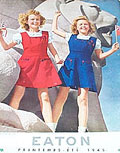 |
|
| |
 Teenage
symbols of hope. Although the catalogue was prepared months in advance,
it appeared after the end of the war in 1945. Eaton's (Toronto) Fall/Winter
Catalogue, 1945. Teenage
symbols of hope. Although the catalogue was prepared months in advance,
it appeared after the end of the war in 1945. Eaton's (Toronto) Fall/Winter
Catalogue, 1945.
|
|
| |
|
|
|
The cover of the 1945 fall-and-winter catalogue pictures two teenage
girls
waving flags. They were an attractive symbol of hope, peace and prosperity
in
post-war Canada, and, at the same time, of Eatonian hopes that they and
their
peers would lead the way as consumers. The catalogues had long targetted
female
teens and simply stepped up these efforts in boom times like this.
Similarly,
the 1947 spring-and-summer book sparkles with trendy prose, pictures, and
products
designed to catch their attention, like shoes in the "frisky
ballerina
style of California inspiration, home of new-as-tomorrow sports
fashions."
| |
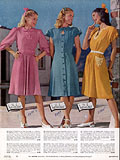 |
|
| |
 Appealing
to trendy teenagers. Eaton's (Toronto) Spring/Summer Catalogue, 1947,
p. 3. Appealing
to trendy teenagers. Eaton's (Toronto) Spring/Summer Catalogue, 1947,
p. 3.
|
|
| |
|
|
|
Eaton's, however, expected teens to be more than just cute and
clothes-conscious.
The company also suggested that they should start exercising some
responsibility
and that shopping was a good way to do so. Eaton's claimed to be
"The Store
for Young Canada." By shopping there, the company implied, teens
would
contribute to national economic recovery.
In comparison, teenage boys get short shrift in the Toronto mail-order
books
where they receive little special treatment, either on covers or inside.
There
was one notable exception, perhaps: It seems that Eaton's may have
encouraged
the tendency of some young men to look at pictures of scantily-clad
females.
In the 1947 book, at least, Eaton's placed the pages for teenage
girls'
lingerie directly after the pages for clothes for boys, where the latter
couldn't
help but stumble across them!
Relatively speaking there was, therefore, a certain gravity to the
Toronto
catalogues' portrayal of girls. Even when presenting them at play,
the
words and pictures emphasized learning to act like women and doing their
duty,
whether it was by raising children or contributing to Canada. The
catalogues
often portrayed adult women in these roles. Thus, taking girls seriously
was
a way for Eaton's to say it honoured the grown-ups they would soon
become.
|
Adult "Women of Canada"
All this being said, it was the adult females Eaton's was most
interested
in. It was the women who purchased not only their own corsets and combs,
but
also many personal items required by their families as well as that
multitude
of fancy or banal things - from linoleum to oleographs - that
made
a house a home.
There were a few lines of goods like tires and tools for use mostly by
men
- such as the suburban "do-it-yourselfers" whose
emergence
Eaton's encouraged - and the company pitched its copy to them
accordingly.
Eaton's also grudgingly conceded that once in a while a man might
buy his
own clothes. An 1893 catalogue used business-like language to appease
them, saying,
"[T]his is properly a woman's store … but we keep a store of
things
[that] the men can find it to their interest to buy, because we keep the
prices
down." What a far cry from the book's chatty, confident call
to the
"women of Canada" to buy lace! It babbled, "[P]erhaps
you know
the difference between one kind and another. Most likely you don't care.
You
want a bit of [it] for a particular purpose ... and you take the most
suitable."
"Women of Canada" were the company's target group. It
was,
obviously, huge and heterogenous. Eaton's sent out catalogues over nine
decades
to homes rural and urban, rich and poor, and was far too savvy to
oversimplify
how it depicted this composite clientele. Instead, it used the catalogues
to
portray women in all walks of life, engaged in everything from baking in a
housedress
to strolling, fur-clad, down some chic street. There was a thread tying
the images
together, however. It was the message that Eaton's, respectfully and
reverently
(and, of course, anxious to make sales), grasped the nature and importance
of
adult women's work.
| |
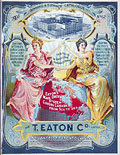 |
|
Eaton's target audience: the
women of Canada. Eaton's (Toronto) Spring/Summer Catalogue, 1904, cover.
|
 |
|
|
Career Women
The company took women's paid work seriously. Early catalogues
brim
with glowing images of its own industrious female employees. Maids'
uniforms
and overalls are among the sober specialized garments for women in the
trades.
The clothing was illustrated as attractively as possible and was often
worn by
pretty models. Smart suits, hats, and such were aimed at office workers.
Eaton's
went further in flattering this group for its glamour: The catalogue sold
one
line of stockings, for instance, "for your party dates - right
for
wearing to the office or shopping - youthful and smart in
appearance."
| |
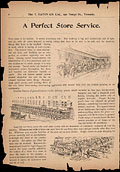 |
|
Eaton's women at work on the
pneumatic cash system. Eaton's (Toronto) Fall/Winter Catalogue, 1894-95,
p. 4 (detail).
|
 |
|
|
Housewives
| |
 |
|
| |
 Women's
work well done: cleaning and shopping on the farm. Eaton's (Toronto)
Spring/Summer, 1926, cover. Women's
work well done: cleaning and shopping on the farm. Eaton's (Toronto)
Spring/Summer, 1926, cover.
|
|
| |
|
|
|
The women's labour to which the catalogues referred the most,
however,
was housework. Hundreds of pages devoted to banal, basic items like the
brushes
and brooms needed to scrub every corner of a home signalled Eaton's
awareness
that housework was a demanding job. The catalogues covered the cleaning
and cooking
still common to most women today, plus the provisioning done by farm women
and
many city-dwellers, especially up to the mid-20th century: gardening,
canning,
sewing. The 1947 spring-and-summer catalogue - aimed at suburbanites
as
much as farm or city women - shows its respect for the latter task
in declaring,
"[M]ore than ever it's thrifty and smart to sew. Don't
wait
- start now and make necessities for the family and the home
...."
Eaton's touted women's skills as housekeepers while emphasizing
their
reliance on the related household job of careful shopping. This meant,
according
to the firm, properly discerning the quality, necessity, and value of
merchandise.
Catalogues of the 1890s flattered their readers as being "expert
judges"
of underwear, for instance, while also saying they were obliged to be so:
"[Y]ou
must distinguish good underwear from poor or buy against your own
interests."
Eaton's was particularly sensible to the fact that, for many women, the
challenge
of careful shopping was intensified by limited budgets. More than frankly
acknowledging
this, the catalogues made a virtue of it, in terms flattering to both its
readers
and Eaton's. Thus did the 1905 fall-and-winter catalogue explain that
"the
successful woman is the one who gets all things of value for as little as
possible.
We supply the best goods at the lowest prices." Satisfaction in
housework
well done: Eaton's acknowledged and promoted it.
Eaton's also said that housework could be not just satisfying but
pleasurable,
and that housewives were artists in their own homes. It was in this spirit
that
the company highlighted the beauty of its goods, like the "Novel and
Rich
Design" of the lace curtains the 1907 catalogue sold. The more that
women
attended to colour, texture, form, and style in their household goods, the
more
fulfilled they would be, said the mail-order books. Of course, once again
in
promoting a role for women - in this case, of taste-maker and
decorator
- Eaton's served its own interests, because the fashionable house
was by
definition always in need of something new.
| |
 |
|
Stylish decorating: a
creative
kind of housework for women. Eaton's (Toronto) Spring/Summer Catalogue,
1938, cover.
|
 |
|
|
Pleasure Seekers
In portraying women's activities, Eaton's tried to strike the
right
balance between promoting their pleasures and honouring their exertions.
This
held true even for the hedonistic pastime of dressing stylishly. Thus,
Eaton's
emphasized the effort, not to mention expense, women expended in
cultivating
this fine art. As the 1893 spring-and-summer mail-order catalogue
explained,
"A man may wear his last year's hat and look tolerably respectable.
Not
so with a woman. Her bonnets must be modish and to a certain extent dress
and
hat and parasol are expected to match." Keeping up, Eaton's implied,
was
work.
| |
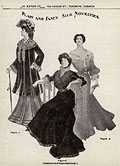 |
|
| |
 Fashion
as luxury and pleasure. Eaton's (Toronto) Spring/Summer Catalogue, 1903,
p. 6. Fashion
as luxury and pleasure. Eaton's (Toronto) Spring/Summer Catalogue, 1903,
p. 6.
|
|
| |
|
|
|
However, the catalogues did focus more on the fantasy and pleasure
aspects
of being in fashion. This was especially clear in the first few pages of
most
Toronto catalogues that presented beautifully illustrated, richly written
homages
to the latest and most luxurious goods available for women's
adornment.
These might be fancy silk yardage, furs, finely tailored suits, or
designer dresses,
all depending on the period.
Many written descriptions heightened the extravagant effect by
wreathing fashions
in opulent promises. In 1894, this meant enticing women with the idea that
"evening"
shades of silk had "the delicious suggestion of the autumn
bridal."
Later depictions of clothes show the models in places such as a foreign
grand
boulevard, hinting that the buyer too would be thus transported - if
only
in her imagination. While it might be a burden, Eaton's seemed to say,
being
in fashion was mostly a luxurious treat, the exception proving the rule
that
most of women's waking hours were spent working.
| |
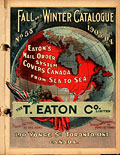 |
|
The catalogue as magic
carpet:
The mail-order books allowed women to travel to grand places, if only
in their imaginations. Eaton's (Toronto) Fall/Winter Catalogue, 1903-04,
p. 1.
|
 |
|
|
Conclusion
The cover of the1965 spring-and-summer catalogue features a woman it
called
"Lovely Maureen Kennedy," who pursued "an active TV and
modelling
career in addition to managing a home and raising four children." It
quoted
her as praising Eaton's goods as "Canadian Standards of Value."
Though
hardly typical, Mrs. Kennedy captured many of the roles Eaton's presented
for
women in its catalogues: housewife and mother, glamorous career woman, and
model
citizen. We may certainly question whether the way Eaton's depicted them
was
true to real women's lives. We can also criticize the motive behind
the
company's message that to do these activities well and to their own
satisfaction,
women needed to excel as mail-order shoppers. But, no matter how limited
and
rosy these roles were, we can still credit Eaton's for presenting, very
publicly,
a reasonably respectful and balanced image of womanhood in its catalogues.
The
mail-order catalogues were, after all, meant to serve as affectionate
tokens
of a company's love for its customers.
|
| |
|
|